Talking about image editing techniques or methods, clipping paths, and image masking go hand in hand. Both these methods are helpful in separating objects from their respective backgrounds and putting them in new backgrounds. So now, when we talk about the difference between these terms, you should know that they are distinct in the way you isolate an object.
Let us go ahead and read in detail about both techniques. Without much ado, let us dig deep and find out how these techniques work. We will first start with the clipping path service.
What is Clipping Path?
The clipping path is a widely used editing method. It has transformed image editing across industries. Firstly, a path is drawn around an object using a pen tool. This isolates the object from its background with precision. Then, the object is moved to a new background. This process is required when the image has sharp and smooth edges. Uses a pen tool, and the lines are straight, so you have to be very careful while making the selection. Also, because the pen tools use straight lines, the images with complex backgrounds or objects are not done properly. For that, image masking is required.
Designers, photo editors, and retouchers widely use clipping paths. They create various effects. Let’s check some of them:
- Isolating an object from its background
- Placing an object on a different background
- Creating a composite image
- Removing unwanted objects from an image
- Adding a drop shadow or other effect to an object
If you draw the wrong clipping path, the images will look unrealistic and artificial. Plus, when selection is made and the object is shifted to a new background, you should smooth the edges by setting the Feather value which will make the object blend in the background. To draw a path around the object, zoom in the image to 200 to 300% in order to get great results. Whenever you start drawing paths, make sure to do it properly, or else you will lose out on a lot of business due to poor-looking images. When there are complex objects or backgrounds, choose Photo masking.
Variants of Clipping Paths
There are several variants of clipping paths, each with its own unique characteristics and applications. Some common variants include:
- Simple Clipping Path: This is the simplest clipping path. It creates a closed outline around an object. It works well for isolating simple objects with clear edges.
- Complex Clipping Path: This clipping path works for complex, layered objects with intricate shapes. It creates multiple paths and then combines them to pinpoint the object’s shape.
- Transparent Clipping Path: This clipping path technique lets an image’s background show through transparent object areas. It’s popular in placing an object on a new background for a realistic effect.
- Alpha Channel Clipping Path: This clipping path uses an alpha channel to control an object’s transparency. It also ensures smooth transitions between the object and its background.
- Vector Clipping Path: This clipping path is made with vector graphics software. It uses points and curves to outline an object’s shape. Its key benefit is that it’s scalable. You can resize it without losing quality.
What is Image Masking?
Image masking removes image backgrounds. However, its method is slightly different. Photo masking uses tools like the magic eraser, background eraser, and color separation in Photoshop. Photoshop masking simplifies background removal. It’s ideal for images with fine, hard-to-trim edges. In eCommerce, clarity is crucial. Use image masking for products. This is for things like jewelry, accessories, or furry items.
Image masking is often used for a variety of purposes, such as:
- Isolating an object from its background
- Removing unwanted objects from an image
- Creating composite images
- Adding special effects to an image
Image masking is also Depending on a few factors like complex editing, multiple background colors, and shadow editing, Photo masking is used in combination with different tools.
Variants of Image Masking:
Image masking is a method in image editing and design. It selectively shows or hides parts of an image. There are many types of masks, each with unique features and uses. Some common types are:
- Layer Mask: This mask is made in image editing software. It lets you hide or show parts of a layer. Also, these masks are non-destructive. So you can adjust them without altering the original image.
- Vector Mask: This mask is made with vector graphics software. It features points and curves that outline its shape. Also, it is easily scalable. You can resize it without losing quality.
- Alpha Channel Mask: This mask uses an alpha channel to control image transparency. It offers precise transparency control. Also, it ensures smooth transitions between the masked area and the background.
Image masking enhances image and graphic quality. If you’re new to it, I recommend learning more. Many online and library resources can guide you.
Difference between Clipping Path service and Image Masking Service
Basically, the clipping path and image masking are two different techniques that involve removing the background using different tools. Complex images require Photo masking whereas simple images are done with clipping paths. The results of Hair masking are flawless and amazing which the clipping path lacks if the image is complex. Decide what type of images you have and make your pick which background removal method you want to use.
Clipping path and image masking are image editing techniques. They remove backgrounds or show/hide parts of an image. However, they have key differences.
Clipping Path Service
- A clipping path is a vital tool for designers. It lets them outline images or graphics with precision. They use a digital pen or drawing tool to carefully trace the object. This method is similar to an artist drawing on paper. The path then acts like digital scissors. It cleanly cuts out the object from its background. Designers use clipping paths in different areas. These include print materials, digital projects, and photo editing. It’s essential for isolating objects accurately.
Image Masking Service
- Image masking is a technique. It involves creating a mask, a grayscale image. The mask shows the areas of the image that should be visible or transparent.
- The mask is then put on the original image. It lets some parts of the image show and hides others.
- Image masking is used for many purposes. These include isolating an object from its background. They also include removing unwanted objects and creating composite images.
The key differences between clipping paths and Image masking are as follows:
- Clipping paths are vector paths, while masks are grayscale images.
- Clipping paths define an object’s boundary. Masks define which parts of an image should be see-through.
- Clipping paths isolate objects from backgrounds. Masks have more uses.
Difference In Usage of Clipping Path Service and Image Masking Service
A clipping path is an exact outline defining the edges of an image. Designers trace this path with a pen or other tool, carefully following the object’s shape. They can then easily remove the object from its background, placing it on a new one or in a composite image.
In design, clipping paths are essential for print, digital media, and photo editing. They cut objects precisely, aiding in design integration. For example, a fashion magazine can isolate a model with a clipping path, making her stand out on a white background. Similarly, it helps designers neatly place logos on websites or business cards.
Image masking is a detailed method of creating a mask to reveal or hide parts of an image. It lets designers control what shows and what doesn’t. This method is used to remove distracting backgrounds, erase unwanted elements, or craft complex images. For instance, a photographer might soften a portrait’s background with image masking. It offers more control over object transparency than clipping paths. This leads to subtle, stylish effects.
Choosing the Right Technique
Choosing between a clipping path and masking depends on your project’s needs. Use a clipping path for a clean, sharp cut with clear edges. Meanwhile, masking offers more transparency, control, and flexibility.
Conclusion:
Basically, the clipping path and image masking are two different techniques that involve removing the background using different tools. Complex images require Photo masking, whereas simple images are done with clipping paths. The results of hair masking are flawless and amazing, but the clipping path is lacking if the image is complex. Decide what type of images you have and make your pick which background removal method you want to use.




